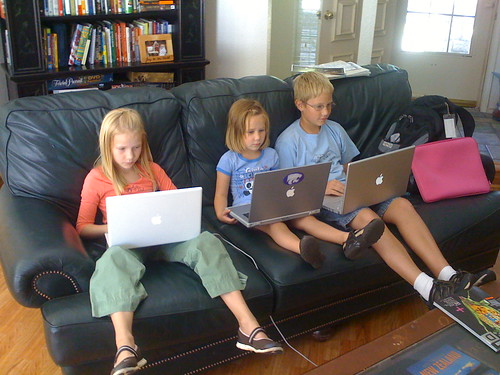Welcome to episode 22 of the EdTech Situation Room from September 14, 2016, where technology news meets educational analysis. This week Jason Neiffer (@techsavvyteach) and Wesley Fryer (@wfryer) had a special show. Rather than discuss a variety of recent technology news headlines, episode 22 focused exclusively on Dr. Nicholas Kardaras’ August 31, 2016 article for TIME Magazine, “Screens In Schools Are a $60 Billion Hoax.” The article highlights many of the key points in Kardaras’ newly published book, “Glow Kids: How Screen Addiction is Hijacking Our Kids—and How to Break the Trance.” Jason and Wes highlighted several of the valid points from the article regarding screentime, the powerful physiological influence of digital screens, and digital addictions. They also acknowledged misdirected educational technology movements, like the interactive whiteboard craze of the 2000’s and the race for educational technology companies to move standardized student assessments onto digital screens. Jason and Wes took issue, however, with Kardaras’ assertion that students in schools are better served with completely screen-free learning experiences. Referencing Neil Postman, John Seely Brown and other authors, they discussed how part of our obligation as educators it to prepare students to navigate the maze of digital distractions and information flows which characterize our modern age. Wes discussed the transformative benefits which digital technology can bring in differentiating reading experiences for students, and highlighted the example of his wife’s 3rd and 4th grade classroom in Oklahoma City which serves homeless students and families. Shelly Fryer (@sfryer) has taught in a 1:1 iPad classroom for the past 3 years, and uses apps like News-O-Matic to provide developmentally appropriate reading articles for students. Her students also use their technology tools to make and create, showing and sharing their learning and their developing skills. Jason took on the question, “If everything Kardaras’ argues is true, then what for schools?” He pointed out we can’t “un-invent” digital screens, so it’s important to help students become more saavy, intentional, and constructive users of digital screens to support learning and healthy living. Geeks of the week included amazing and affordable headphones from Monoprice (via Jason) and the free coding app for young kids, PBS Scratch Jr (from Wes). Check out past episode shownotes on https://edtechsr.com/links and be sure to follow @edtechSR for updates on Twitter http://twitter.com/edtechsr as well as on Facebook. If you listen to the show, please submit our listener survey using the shortened link http://wfryer.me/edtechsr which forwards to a Google Form. Your feedback and suggestions on the show are appreciated!
Shownotes:
- EdTech Situation Room Listener Survey: wfryer.me/edtechsr
- Follow @edtechSR on Twitter!
- Audio podcast feed (Subscribe with iTunes or Stitcher)
- Video version on YouTube
- Check out our video podcast feed and subscribe to our YouTube Channel (episodes also in this YouTube playlist)
- Jason Neiffer (@techsavvyteach)
- Wesley Fryer (@wfryer)
- Screens In Schools Are a $60 Billion Hoax (by Nicholas Kardaras, Time Magazine, 31 August 2016)
- “Glow Kids: How Screen Addiction is Hijacking Our Kids—and How to Break the Trance” by Nicholas Kardaras (2016)
- “How Plato and Pythagoras Can Save your Life” by Nicholas Kardaras (2011)
- [VIDEO] Back from the dead | Nicholas Kardaras | TEDxUrsulineCollege (Nov 2014)
- “Evidence for striatal dopamine release during a video game” by M. J. Koepp, R. N. Gunn, A. D. Lawrence, V. J. Cunningham, A. Dagher, T. Jones, D. J. Brooks, C. J. Bench & P. M. Grasby (PDF – 1998)
- Digital screens have powerful psychological effects! See edtechSR episode 12: How Technology Hijacks People’s Minds — from a Magician and Google’s Design Ethicist (Tristan Harris, 19 May 2016)
- A New Culture of Learning: Cultivating the Imagination for a World of Constant Change by Douglas Thomas and John Seely Brown (@jseelybrown) – www.newcultureoflearning.com
- News-o-Matic
- “Oversold and Underused” by Larry Cuban (2003) – @cubanlarry
- “Failure to Connect: How Computers Affect Our Children’s Minds — and What We Can Do About It” by Jane Healy
- “Information Anxiety 2” by Richard Wurman (2000)
- “Growing Up Digital: The Rise of the Net Generation” by Don Tapscott (1999) – @dtapscott
- “Life on the Screen: Identity in the Age of the Internet” by Sherry Turkle (1995, 1997) – @STurkle
- “The Flickering Mind: Saving Education from the False Promise of Technology” by Todd Oppenheimer (2004)
- Ninja Cat – Stalking Cat (>47 million views)
- “Teaching as a Subversive Activity: A No-Holds-Barred Assault on Outdated Teaching Methods-with Dramatic and Practical Proposals on How Education Can Be Made Relevant to Today’s World” by Neil Postman (1971)
- Rachel Fryer’s 500 Subscriber Special on YouTube – rachelfryer.com (@rachfMC)
- “The Attention Economy and the Net” by Michael H. Goldhaber
- Shelly Fryer’s Classroom Website – shellyfryer.com (@sfryer)
- Show with Media: What Do You Want to Create Today?
- Learning Showcase of Casady School (Oklahoma City)
- Learning Showcase of Yukon Public Schools (Yukon, Oklahoma)
- #OklaEd Oklahoma Learning Showcase
- Fall 2016 #STEAM Studio resources by Megan Thompson (@seeingnewshapes) and Wes Fryer
- Jason’s Geek of the Week: Monoprice Over-the-Ear Headphones
- Wes’ Geek of the Week: PBS Scratch Jr (workshop tutorial videos & resources by @sfryer)
Correction to tonight's @edtechSR: Author of "The Attention Economy and the Net" was Michael H. Goldhaber https://t.co/jUyC8CDm4W
— Wesley Fryer (@wfryer) September 15, 2016
#book2read: "Information Anxiety 2" by Richard Wurman via @techsavvyteach on @edtechsr #edtechSR #AttentionEconomy https://t.co/e6nDYloFJ0
— Wesley Fryer (@wfryer) September 15, 2016
A few books about screen time, technology & kids mentioned in tonight's @edtechsr show! #edtechSR pic.twitter.com/RGV52GFvz3
— Wesley Fryer (@wfryer) September 15, 2016
Oh my gosh!! We did it!!!! 500 SUBSCRIBERS! 😃 ✨
I can't thank you guys enough! Thank you so much 💕💕💕 pic.twitter.com/8wYjABi7qC— 🎃RachelArtist🎃 (@RachfMC) September 2, 2016
